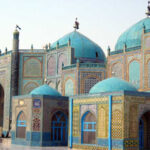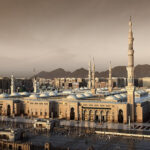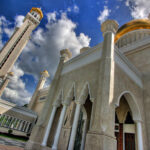Khalid’s transfer to Syria.
In May 634 C.E. while Khalid bin Walid was at Al Hirah, he received orders from Abu Bakr that he should proceed with all possible haste to Syria to take over the command of the Muslim forces in Syria and lead the operations there.
With the departure of Khalid from Iraq, Al Muthanna was to be the Commander of the Muslim forces in Iraq. On receiving these orders, Khalid divided the Muslim forces in Iraq in two corps. One corps he left with Al Muthanna in Iraq and with the other corps he proceeded to Syria.
Route to Syria.
The main point that Khalid had to decide was as to the route by which he should march to Syria. The southern route led via Daumatul Jandal. It was the easiest and the simplest route.
It was, however, a long route, and the march was likely to take a considerable time. The other route in the north lay along the Euphrates. It was not the proper route to be followed for it was studded with numerous cantonments garrisoned by the Byzantine soldiers.
Khalid was keen to know of some other shorter route to Syria. One of the soldiers of the army of Khalid, Rafe’ bin Umeira declared that there was another route through the land of Samawa.
Through this route, the entire journey was to take five days only. The difficulty, however, was the region was a barren and waterless desert, and because of the want of water, considerable difficulties had to be faced by the travelers. Rafe’ was of the view that the Samawa route was not a proper route for the army, as it involved extreme hardships, absence of water, and the risk of losing the way.
Urged by the spirit of adventure, Khalid decided that he would follow the Samawa route, whatever the risks. This dangerous decision alarmed them, but he addressed them “Let not your resolve be weakened. Allah will help you and why should you fear anything when you have the help of Allah? “
March to Syria.
In early June 634 C.E., Khalid marched from Al Hirah with his corps of 9,000 men. From Al Hirah they proceeded to ‘Ein at Tamr, Sandauda, Mazayyah and Qaraqir. At Qaraqir, the army filled the water skins and other containers with water that could last for five days. Old camels were made to drink water to their full, so that they could serve as reservoirs of water in case of emergency.
Plunge into the desert.
On the following morning, taking the name of Allah, the army plunged into the trackless desert. The journey through the desert proved to be very hard and oppressive. Things became difficult when the water supply expected to last for five days was exhausted in three days. On the fourth day, in the absence of water, things became very difficult for the army.
Some of the camels were slaughtered, and the water stored in their stomachs was utilized for the watering of horses. By the end of the fourth day, the men of Khalid reached the limits of human endurance. On the fifth day, the army reached the site where according to the guide; there should have been a spring of water. The spring of water was, however, nowhere to be found. This led to a feeling of great disappointment and frustration among the army. On further search and some trial diggings, a spring of water was after all found. That was the end of all trouble and anxiety. Men and animals drank their fill, and praised God for His mercy.
Suwa.
The rest of the march through the desert was no longer oppressive. After a day’s march, the Muslim army reached Suwa. That was the first settlement in Syria. It was an oasis surrounded by a pastureland where there were large flocks of sheep and herds of cattle. The Muslims captured all the flocks and herds to serve for the army’s food during the campaigns to follow.
Arak.
The following day, the Muslim army reached Arak, which was a fortified town. The Byzantine garrison found resistance futile. They laid down arms, and the people of the town agreed to pay Jizya. The pact of peace was signed and the Muslims occupied the fort.
Tadmur.
From Arak, the Muslim army advanced to Tadmur, where was a Christian Arab garrison, who shut themselves in the fort at the arrival of the Muslim army. The Muslims besieged the fort, and finding resistance useless, the Christian Arabs asked for terms. They surrendered and agreed to pay Jizya.
Qaryatein.
From Tadmur, the Muslim army marched to Qaryatein. The Byzantine garrison here decided to resist. In the fight that followed, the Byzantine garrison was annihilated to a man. The people of the town sued for terms, and agreed to pay Jizya.
Huwareen.
From Qaryatein, the Muslims marched to Huwareen, some ten miles away. Here the Muslims had to fight against the local inhabitants reinforced by a contingent of the Ghassans who had come to the relief of the local inhabitants. The Byzantines and the Ghassans were cut to pieces. The survivors laid down arms, and a peace pact was signed whereunder people agreed to pay Jizya.
Pass of the eagle.
From Huwareen the Muslim army took the road to Damascus. They halted at a pass twenty miles from Damascus. At this pass in the Jabal-us-Sharq range, Khalid fluttered his standard bearing the ‘eagle’, and because of such standard, the pass came to be known as “Saniyyat-ul-Uqab”, i.e. the pass of the eagle.
Marj Rahit.
From the pass, the Muslim army advanced to Marj Rahit. A garrison here offered some resistance, but was soon overpowered. The garrison surrendered and the Muslims amassed considerable booty. From Marj Rahit, the Muslim army under Khalid marched to Busra.
Visits: 0















